Contemporary Issues: Salomon v Salomon and the Corporate Veil Doctrine
VerifiedAdded on 2022/08/12
|15
|3807
|25
Case Study
AI Summary
This case study provides an in-depth analysis of the landmark Salomon v Salomon case, focusing on the principle of separate legal entity and the doctrine of the corporate veil. It examines the facts of the case, where Mr. Aron Salomon incorporated a company and subsequently faced challenges regarding his status as a secured creditor. The study also explores supporting case laws, such as Lee v. Lee’s Air Farming and Macaura v Northern Assurance, which uphold the Salomon principle. Furthermore, it discusses exceptions to the principle, including instances of fraud and injustice, where the corporate veil may be lifted. The study elaborates on grounds for lifting the corporate veil, particularly in cases involving fraud, and references cases like Gilford Motor Company Ltd v Horne and Jones v. Lipman to illustrate how courts address fraudulent activities masked by corporate structures. The analysis emphasizes the importance of balancing the principle of separate legal entity with the need to prevent abuse and ensure fair justice, highlighting the complexities of corporate law and its application in contemporary legal scenarios. Desklib provides additional resources for students to explore similar cases and assignments.

Running head: THE SALOMON CASE AND THE CONTEMPORARY ISSUES
THE SALOMON CASE AND THE CONTEMPORARY ISSUES
Name of the Student:
Name of the University:
Author Note:
THE SALOMON CASE AND THE CONTEMPORARY ISSUES
Name of the Student:
Name of the University:
Author Note:
Paraphrase This Document
Need a fresh take? Get an instant paraphrase of this document with our AI Paraphraser
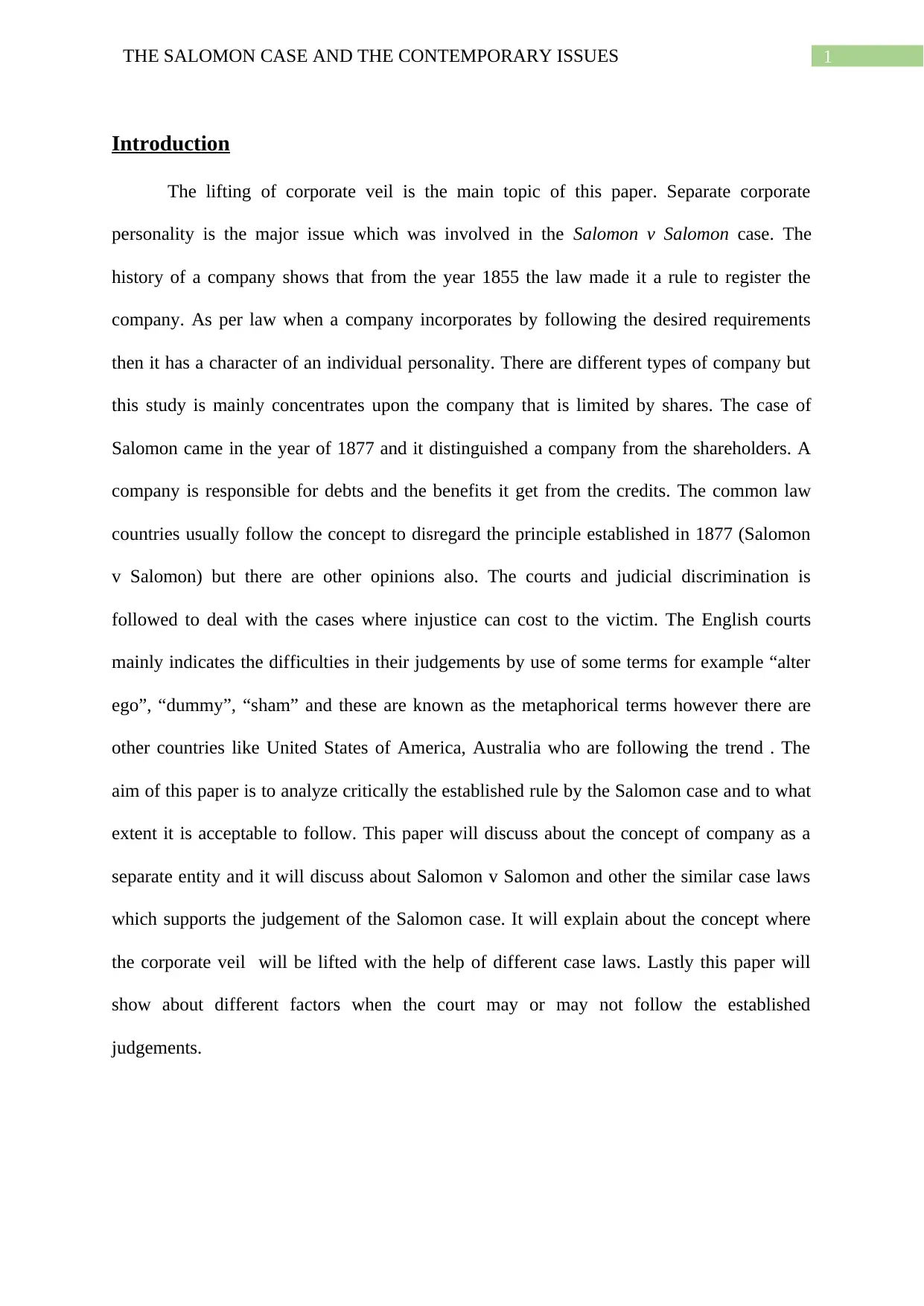
1THE SALOMON CASE AND THE CONTEMPORARY ISSUES
Introduction
The lifting of corporate veil is the main topic of this paper. Separate corporate
personality is the major issue which was involved in the Salomon v Salomon case. The
history of a company shows that from the year 1855 the law made it a rule to register the
company. As per law when a company incorporates by following the desired requirements
then it has a character of an individual personality. There are different types of company but
this study is mainly concentrates upon the company that is limited by shares. The case of
Salomon came in the year of 1877 and it distinguished a company from the shareholders. A
company is responsible for debts and the benefits it get from the credits. The common law
countries usually follow the concept to disregard the principle established in 1877 (Salomon
v Salomon) but there are other opinions also. The courts and judicial discrimination is
followed to deal with the cases where injustice can cost to the victim. The English courts
mainly indicates the difficulties in their judgements by use of some terms for example “alter
ego”, “dummy”, “sham” and these are known as the metaphorical terms however there are
other countries like United States of America, Australia who are following the trend . The
aim of this paper is to analyze critically the established rule by the Salomon case and to what
extent it is acceptable to follow. This paper will discuss about the concept of company as a
separate entity and it will discuss about Salomon v Salomon and other the similar case laws
which supports the judgement of the Salomon case. It will explain about the concept where
the corporate veil will be lifted with the help of different case laws. Lastly this paper will
show about different factors when the court may or may not follow the established
judgements.
Introduction
The lifting of corporate veil is the main topic of this paper. Separate corporate
personality is the major issue which was involved in the Salomon v Salomon case. The
history of a company shows that from the year 1855 the law made it a rule to register the
company. As per law when a company incorporates by following the desired requirements
then it has a character of an individual personality. There are different types of company but
this study is mainly concentrates upon the company that is limited by shares. The case of
Salomon came in the year of 1877 and it distinguished a company from the shareholders. A
company is responsible for debts and the benefits it get from the credits. The common law
countries usually follow the concept to disregard the principle established in 1877 (Salomon
v Salomon) but there are other opinions also. The courts and judicial discrimination is
followed to deal with the cases where injustice can cost to the victim. The English courts
mainly indicates the difficulties in their judgements by use of some terms for example “alter
ego”, “dummy”, “sham” and these are known as the metaphorical terms however there are
other countries like United States of America, Australia who are following the trend . The
aim of this paper is to analyze critically the established rule by the Salomon case and to what
extent it is acceptable to follow. This paper will discuss about the concept of company as a
separate entity and it will discuss about Salomon v Salomon and other the similar case laws
which supports the judgement of the Salomon case. It will explain about the concept where
the corporate veil will be lifted with the help of different case laws. Lastly this paper will
show about different factors when the court may or may not follow the established
judgements.

2THE SALOMON CASE AND THE CONTEMPORARY ISSUES
The Case of Salomon
Salomon v Salomon1 is considered as landmark case for the company as a separate
entity2. The facts of the case shows that Mr. Aron Salomon was a businessman who was
engaged in leather manufacturing. Mr. Aron in the year 1892 decided to open a company
limited by shares. The law required that to form a limited company there must be seven
individuals. Mr. Aron in order to fulfill the criteria made his wife, daughter and four sons as
the shareholders and named the company as Salomon and Co Ltd. Mr. Aron sold the business
to the company, and got the debentures of 10 pounds. At a point the business collapsed and
Mr. Aron claimed to get the benefits of a secured creditor but the liquidator rejected the claim
that both the company and Mr. Salomon were same and fraud was done by him. The court of
first instance accepted the views of the liquidator however The House of Lords on appeal
observed the case differently and held that both of the entities were different and both of them
were holding different liabilities. The company is treated as an artificial person3 so when it
comes into existence it must observe all the rights and liabilities as an individual.
Supporting Case laws of Salomon Case
There are other case laws which showed the similarities of Solomon case. In Lee v.
Lee’s Air Farming4 case Lee by profession was a pilot. Lee formed the company and Lee was
also playing the role of an employee and Lee was killed while performing the duties of an
employee and after Lee’s death his wife claimed under workers’ compensation. According to
the New Zealand Court rejected to treat Mr. Lee as an employee however the Privy council
through appeal held that Lee and the company were separate people in the eye of law. Lee
1 Salomon v. Salomon & Co. Ltd. [1897] A.C. 22.
2 Pickering, Murray A. "The company as a separate legal entity." The Modern Law Review 31.5 (1968): 481-
511.
3 Odumosu, Damilola O., and Solomon T. Grace. "ARTIFICIAL INTELLIGENCE AND LEGAL
PERSONALITY: ANY RESCUE FROM SALOMON V. SALOMON?." IX International Conference on
Complex Systems. 2018.
4 Lee v. Lee's Air Farming [1961] A.C. 12.
The Case of Salomon
Salomon v Salomon1 is considered as landmark case for the company as a separate
entity2. The facts of the case shows that Mr. Aron Salomon was a businessman who was
engaged in leather manufacturing. Mr. Aron in the year 1892 decided to open a company
limited by shares. The law required that to form a limited company there must be seven
individuals. Mr. Aron in order to fulfill the criteria made his wife, daughter and four sons as
the shareholders and named the company as Salomon and Co Ltd. Mr. Aron sold the business
to the company, and got the debentures of 10 pounds. At a point the business collapsed and
Mr. Aron claimed to get the benefits of a secured creditor but the liquidator rejected the claim
that both the company and Mr. Salomon were same and fraud was done by him. The court of
first instance accepted the views of the liquidator however The House of Lords on appeal
observed the case differently and held that both of the entities were different and both of them
were holding different liabilities. The company is treated as an artificial person3 so when it
comes into existence it must observe all the rights and liabilities as an individual.
Supporting Case laws of Salomon Case
There are other case laws which showed the similarities of Solomon case. In Lee v.
Lee’s Air Farming4 case Lee by profession was a pilot. Lee formed the company and Lee was
also playing the role of an employee and Lee was killed while performing the duties of an
employee and after Lee’s death his wife claimed under workers’ compensation. According to
the New Zealand Court rejected to treat Mr. Lee as an employee however the Privy council
through appeal held that Lee and the company were separate people in the eye of law. Lee
1 Salomon v. Salomon & Co. Ltd. [1897] A.C. 22.
2 Pickering, Murray A. "The company as a separate legal entity." The Modern Law Review 31.5 (1968): 481-
511.
3 Odumosu, Damilola O., and Solomon T. Grace. "ARTIFICIAL INTELLIGENCE AND LEGAL
PERSONALITY: ANY RESCUE FROM SALOMON V. SALOMON?." IX International Conference on
Complex Systems. 2018.
4 Lee v. Lee's Air Farming [1961] A.C. 12.
⊘ This is a preview!⊘
Do you want full access?
Subscribe today to unlock all pages.

Trusted by 1+ million students worldwide
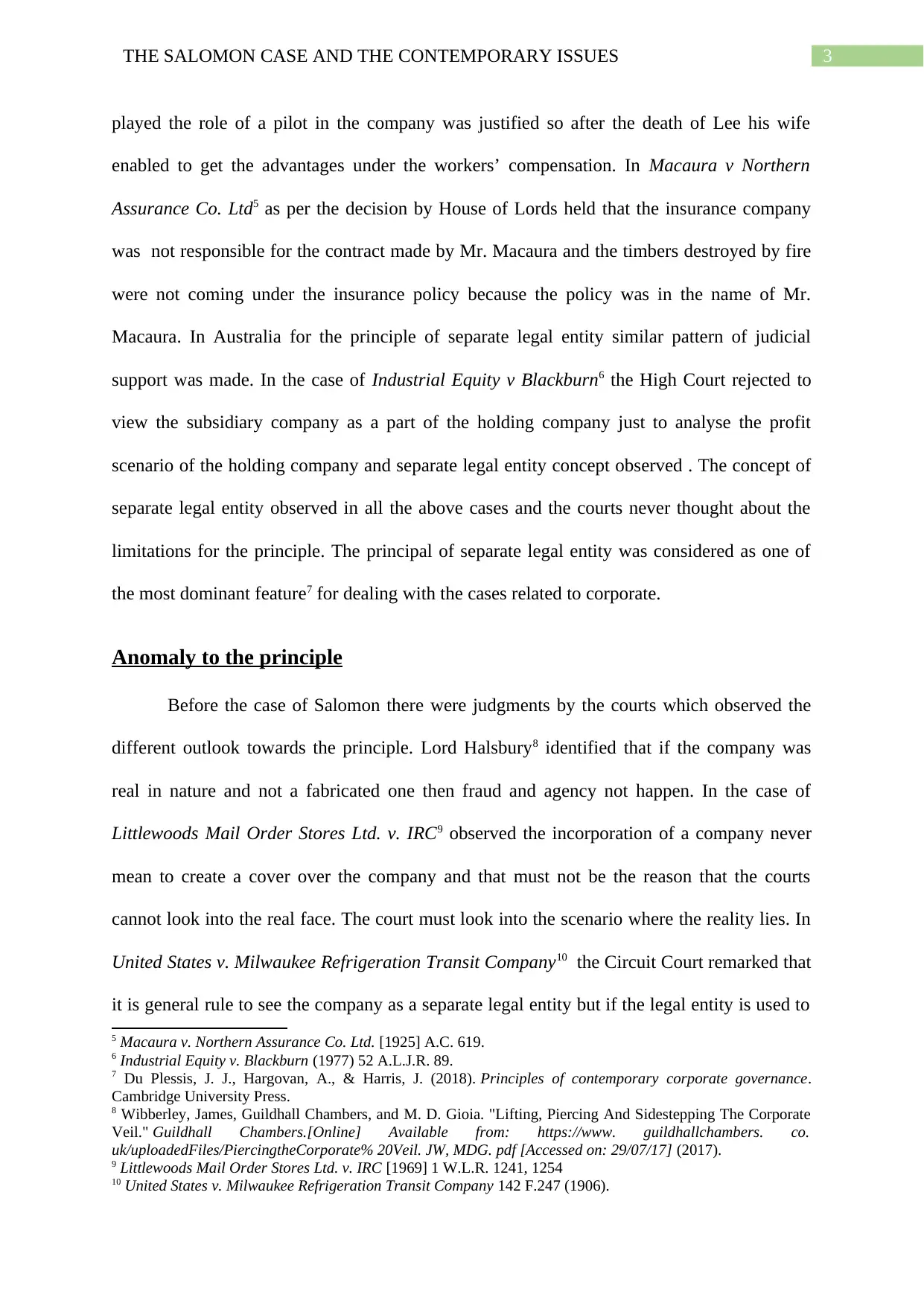
3THE SALOMON CASE AND THE CONTEMPORARY ISSUES
played the role of a pilot in the company was justified so after the death of Lee his wife
enabled to get the advantages under the workers’ compensation. In Macaura v Northern
Assurance Co. Ltd5 as per the decision by House of Lords held that the insurance company
was not responsible for the contract made by Mr. Macaura and the timbers destroyed by fire
were not coming under the insurance policy because the policy was in the name of Mr.
Macaura. In Australia for the principle of separate legal entity similar pattern of judicial
support was made. In the case of Industrial Equity v Blackburn6 the High Court rejected to
view the subsidiary company as a part of the holding company just to analyse the profit
scenario of the holding company and separate legal entity concept observed . The concept of
separate legal entity observed in all the above cases and the courts never thought about the
limitations for the principle. The principal of separate legal entity was considered as one of
the most dominant feature7 for dealing with the cases related to corporate.
Anomaly to the principle
Before the case of Salomon there were judgments by the courts which observed the
different outlook towards the principle. Lord Halsbury8 identified that if the company was
real in nature and not a fabricated one then fraud and agency not happen. In the case of
Littlewoods Mail Order Stores Ltd. v. IRC9 observed the incorporation of a company never
mean to create a cover over the company and that must not be the reason that the courts
cannot look into the real face. The court must look into the scenario where the reality lies. In
United States v. Milwaukee Refrigeration Transit Company10 the Circuit Court remarked that
it is general rule to see the company as a separate legal entity but if the legal entity is used to
5 Macaura v. Northern Assurance Co. Ltd. [1925] A.C. 619.
6 Industrial Equity v. Blackburn (1977) 52 A.L.J.R. 89.
7 Du Plessis, J. J., Hargovan, A., & Harris, J. (2018). Principles of contemporary corporate governance.
Cambridge University Press.
8 Wibberley, James, Guildhall Chambers, and M. D. Gioia. "Lifting, Piercing And Sidestepping The Corporate
Veil." Guildhall Chambers.[Online] Available from: https://www. guildhallchambers. co.
uk/uploadedFiles/PiercingtheCorporate% 20Veil. JW, MDG. pdf [Accessed on: 29/07/17] (2017).
9 Littlewoods Mail Order Stores Ltd. v. IRC [1969] 1 W.L.R. 1241, 1254
10 United States v. Milwaukee Refrigeration Transit Company 142 F.247 (1906).
played the role of a pilot in the company was justified so after the death of Lee his wife
enabled to get the advantages under the workers’ compensation. In Macaura v Northern
Assurance Co. Ltd5 as per the decision by House of Lords held that the insurance company
was not responsible for the contract made by Mr. Macaura and the timbers destroyed by fire
were not coming under the insurance policy because the policy was in the name of Mr.
Macaura. In Australia for the principle of separate legal entity similar pattern of judicial
support was made. In the case of Industrial Equity v Blackburn6 the High Court rejected to
view the subsidiary company as a part of the holding company just to analyse the profit
scenario of the holding company and separate legal entity concept observed . The concept of
separate legal entity observed in all the above cases and the courts never thought about the
limitations for the principle. The principal of separate legal entity was considered as one of
the most dominant feature7 for dealing with the cases related to corporate.
Anomaly to the principle
Before the case of Salomon there were judgments by the courts which observed the
different outlook towards the principle. Lord Halsbury8 identified that if the company was
real in nature and not a fabricated one then fraud and agency not happen. In the case of
Littlewoods Mail Order Stores Ltd. v. IRC9 observed the incorporation of a company never
mean to create a cover over the company and that must not be the reason that the courts
cannot look into the real face. The court must look into the scenario where the reality lies. In
United States v. Milwaukee Refrigeration Transit Company10 the Circuit Court remarked that
it is general rule to see the company as a separate legal entity but if the legal entity is used to
5 Macaura v. Northern Assurance Co. Ltd. [1925] A.C. 619.
6 Industrial Equity v. Blackburn (1977) 52 A.L.J.R. 89.
7 Du Plessis, J. J., Hargovan, A., & Harris, J. (2018). Principles of contemporary corporate governance.
Cambridge University Press.
8 Wibberley, James, Guildhall Chambers, and M. D. Gioia. "Lifting, Piercing And Sidestepping The Corporate
Veil." Guildhall Chambers.[Online] Available from: https://www. guildhallchambers. co.
uk/uploadedFiles/PiercingtheCorporate% 20Veil. JW, MDG. pdf [Accessed on: 29/07/17] (2017).
9 Littlewoods Mail Order Stores Ltd. v. IRC [1969] 1 W.L.R. 1241, 1254
10 United States v. Milwaukee Refrigeration Transit Company 142 F.247 (1906).
Paraphrase This Document
Need a fresh take? Get an instant paraphrase of this document with our AI Paraphraser
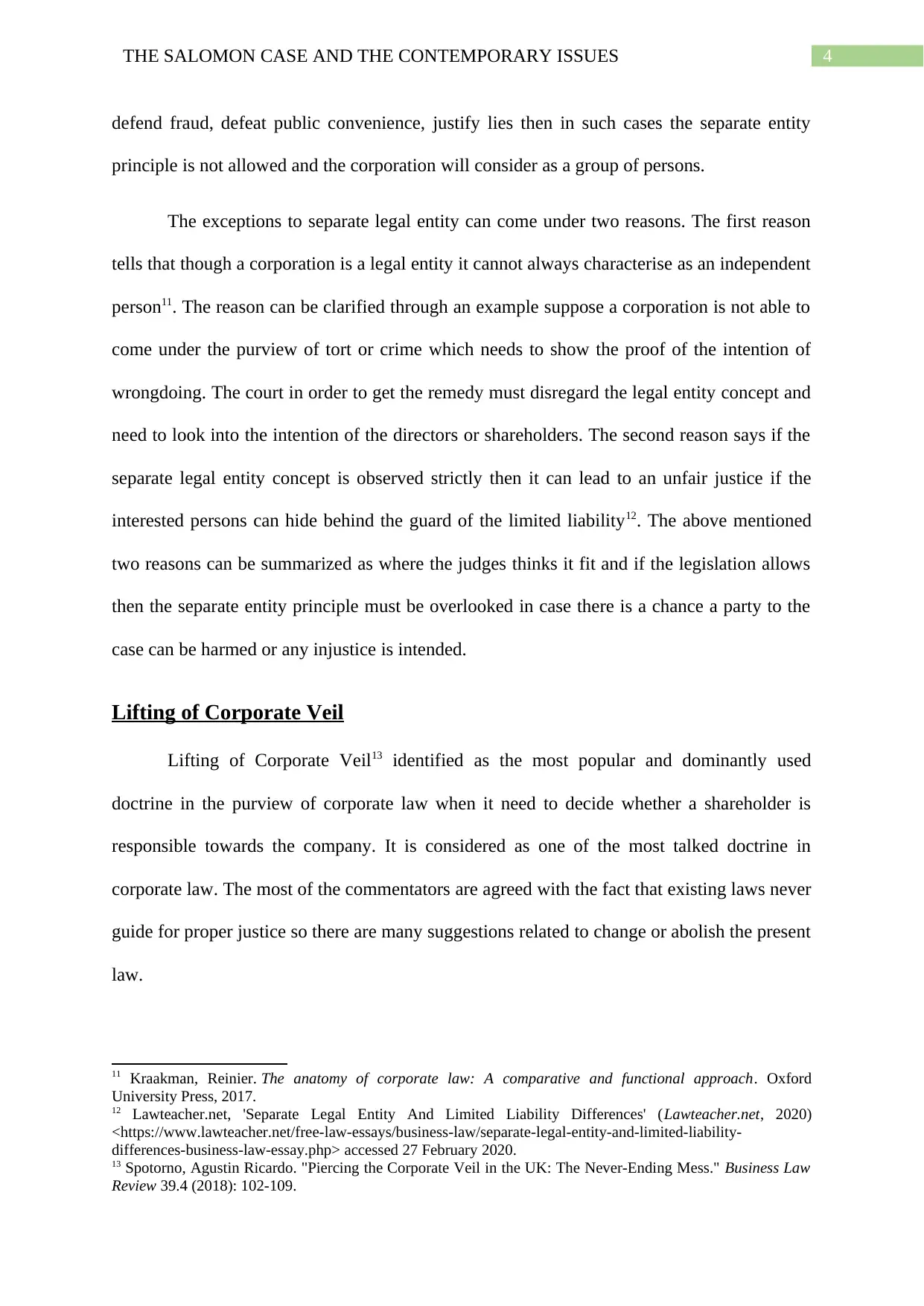
4THE SALOMON CASE AND THE CONTEMPORARY ISSUES
defend fraud, defeat public convenience, justify lies then in such cases the separate entity
principle is not allowed and the corporation will consider as a group of persons.
The exceptions to separate legal entity can come under two reasons. The first reason
tells that though a corporation is a legal entity it cannot always characterise as an independent
person11. The reason can be clarified through an example suppose a corporation is not able to
come under the purview of tort or crime which needs to show the proof of the intention of
wrongdoing. The court in order to get the remedy must disregard the legal entity concept and
need to look into the intention of the directors or shareholders. The second reason says if the
separate legal entity concept is observed strictly then it can lead to an unfair justice if the
interested persons can hide behind the guard of the limited liability12. The above mentioned
two reasons can be summarized as where the judges thinks it fit and if the legislation allows
then the separate entity principle must be overlooked in case there is a chance a party to the
case can be harmed or any injustice is intended.
Lifting of Corporate Veil
Lifting of Corporate Veil13 identified as the most popular and dominantly used
doctrine in the purview of corporate law when it need to decide whether a shareholder is
responsible towards the company. It is considered as one of the most talked doctrine in
corporate law. The most of the commentators are agreed with the fact that existing laws never
guide for proper justice so there are many suggestions related to change or abolish the present
law.
11 Kraakman, Reinier. The anatomy of corporate law: A comparative and functional approach. Oxford
University Press, 2017.
12 Lawteacher.net, 'Separate Legal Entity And Limited Liability Differences' (Lawteacher.net, 2020)
<https://www.lawteacher.net/free-law-essays/business-law/separate-legal-entity-and-limited-liability-
differences-business-law-essay.php> accessed 27 February 2020.
13 Spotorno, Agustin Ricardo. "Piercing the Corporate Veil in the UK: The Never-Ending Mess." Business Law
Review 39.4 (2018): 102-109.
defend fraud, defeat public convenience, justify lies then in such cases the separate entity
principle is not allowed and the corporation will consider as a group of persons.
The exceptions to separate legal entity can come under two reasons. The first reason
tells that though a corporation is a legal entity it cannot always characterise as an independent
person11. The reason can be clarified through an example suppose a corporation is not able to
come under the purview of tort or crime which needs to show the proof of the intention of
wrongdoing. The court in order to get the remedy must disregard the legal entity concept and
need to look into the intention of the directors or shareholders. The second reason says if the
separate legal entity concept is observed strictly then it can lead to an unfair justice if the
interested persons can hide behind the guard of the limited liability12. The above mentioned
two reasons can be summarized as where the judges thinks it fit and if the legislation allows
then the separate entity principle must be overlooked in case there is a chance a party to the
case can be harmed or any injustice is intended.
Lifting of Corporate Veil
Lifting of Corporate Veil13 identified as the most popular and dominantly used
doctrine in the purview of corporate law when it need to decide whether a shareholder is
responsible towards the company. It is considered as one of the most talked doctrine in
corporate law. The most of the commentators are agreed with the fact that existing laws never
guide for proper justice so there are many suggestions related to change or abolish the present
law.
11 Kraakman, Reinier. The anatomy of corporate law: A comparative and functional approach. Oxford
University Press, 2017.
12 Lawteacher.net, 'Separate Legal Entity And Limited Liability Differences' (Lawteacher.net, 2020)
<https://www.lawteacher.net/free-law-essays/business-law/separate-legal-entity-and-limited-liability-
differences-business-law-essay.php> accessed 27 February 2020.
13 Spotorno, Agustin Ricardo. "Piercing the Corporate Veil in the UK: The Never-Ending Mess." Business Law
Review 39.4 (2018): 102-109.
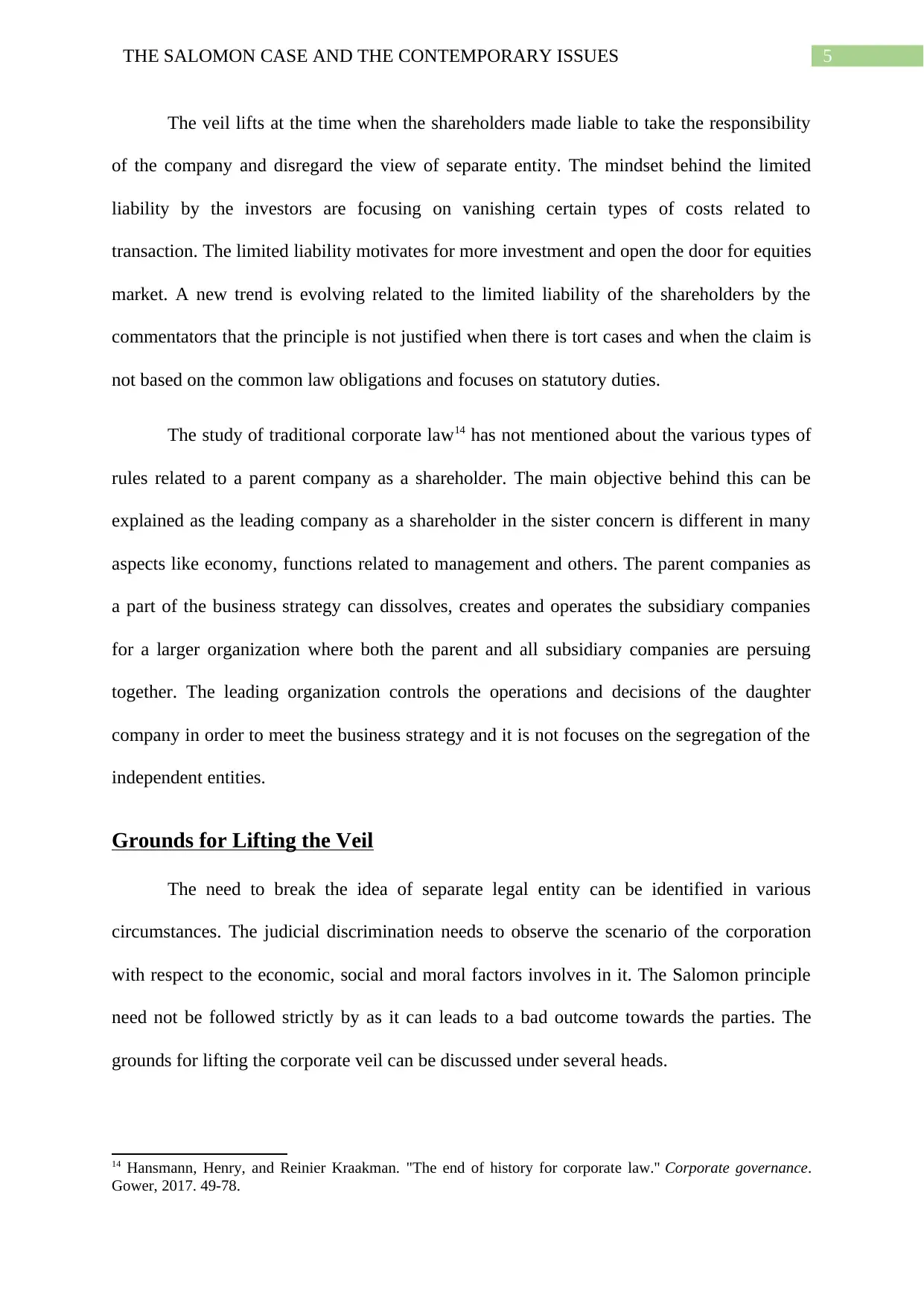
5THE SALOMON CASE AND THE CONTEMPORARY ISSUES
The veil lifts at the time when the shareholders made liable to take the responsibility
of the company and disregard the view of separate entity. The mindset behind the limited
liability by the investors are focusing on vanishing certain types of costs related to
transaction. The limited liability motivates for more investment and open the door for equities
market. A new trend is evolving related to the limited liability of the shareholders by the
commentators that the principle is not justified when there is tort cases and when the claim is
not based on the common law obligations and focuses on statutory duties.
The study of traditional corporate law14 has not mentioned about the various types of
rules related to a parent company as a shareholder. The main objective behind this can be
explained as the leading company as a shareholder in the sister concern is different in many
aspects like economy, functions related to management and others. The parent companies as
a part of the business strategy can dissolves, creates and operates the subsidiary companies
for a larger organization where both the parent and all subsidiary companies are persuing
together. The leading organization controls the operations and decisions of the daughter
company in order to meet the business strategy and it is not focuses on the segregation of the
independent entities.
Grounds for Lifting the Veil
The need to break the idea of separate legal entity can be identified in various
circumstances. The judicial discrimination needs to observe the scenario of the corporation
with respect to the economic, social and moral factors involves in it. The Salomon principle
need not be followed strictly by as it can leads to a bad outcome towards the parties. The
grounds for lifting the corporate veil can be discussed under several heads.
14 Hansmann, Henry, and Reinier Kraakman. "The end of history for corporate law." Corporate governance.
Gower, 2017. 49-78.
The veil lifts at the time when the shareholders made liable to take the responsibility
of the company and disregard the view of separate entity. The mindset behind the limited
liability by the investors are focusing on vanishing certain types of costs related to
transaction. The limited liability motivates for more investment and open the door for equities
market. A new trend is evolving related to the limited liability of the shareholders by the
commentators that the principle is not justified when there is tort cases and when the claim is
not based on the common law obligations and focuses on statutory duties.
The study of traditional corporate law14 has not mentioned about the various types of
rules related to a parent company as a shareholder. The main objective behind this can be
explained as the leading company as a shareholder in the sister concern is different in many
aspects like economy, functions related to management and others. The parent companies as
a part of the business strategy can dissolves, creates and operates the subsidiary companies
for a larger organization where both the parent and all subsidiary companies are persuing
together. The leading organization controls the operations and decisions of the daughter
company in order to meet the business strategy and it is not focuses on the segregation of the
independent entities.
Grounds for Lifting the Veil
The need to break the idea of separate legal entity can be identified in various
circumstances. The judicial discrimination needs to observe the scenario of the corporation
with respect to the economic, social and moral factors involves in it. The Salomon principle
need not be followed strictly by as it can leads to a bad outcome towards the parties. The
grounds for lifting the corporate veil can be discussed under several heads.
14 Hansmann, Henry, and Reinier Kraakman. "The end of history for corporate law." Corporate governance.
Gower, 2017. 49-78.
⊘ This is a preview!⊘
Do you want full access?
Subscribe today to unlock all pages.

Trusted by 1+ million students worldwide
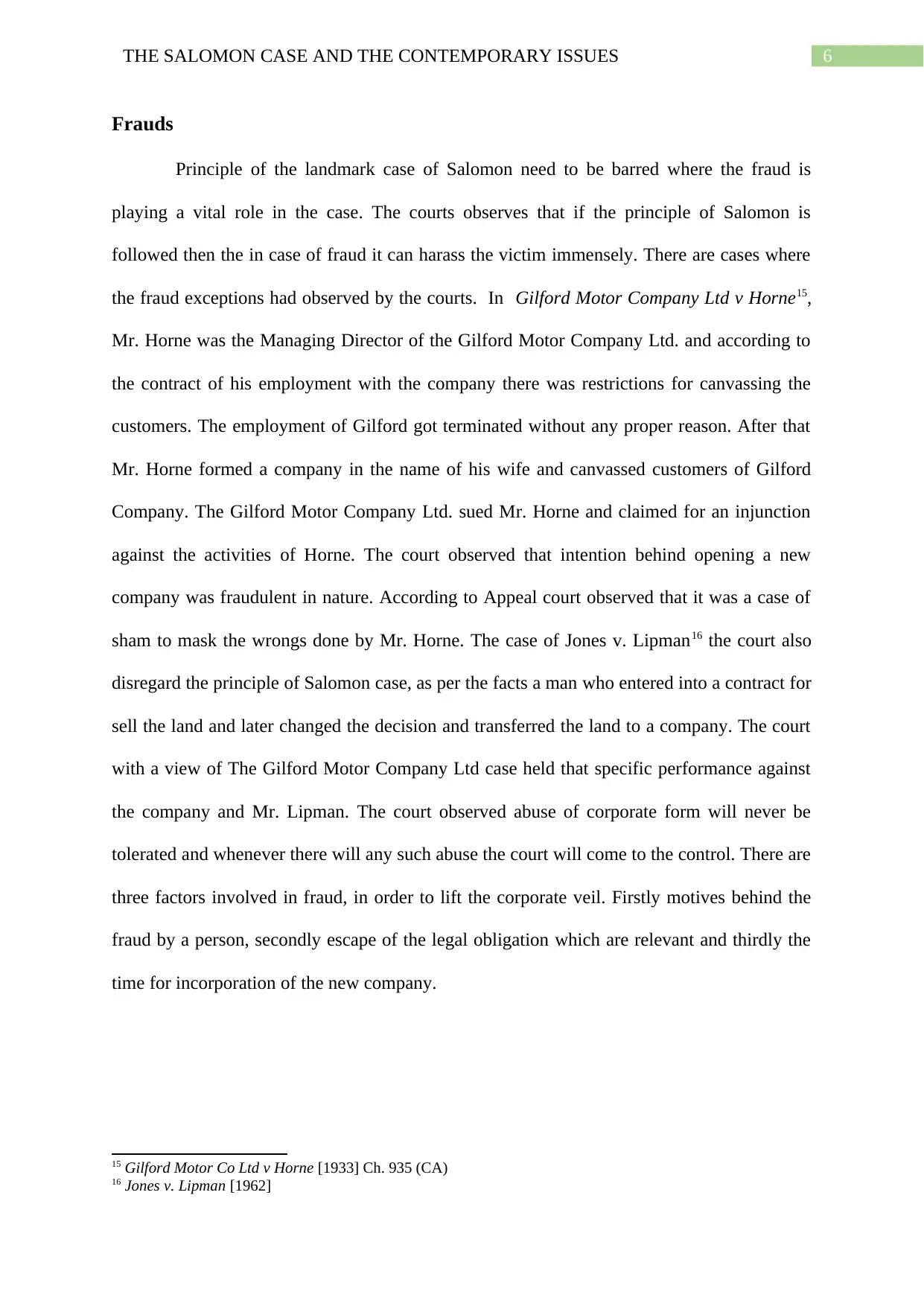
6THE SALOMON CASE AND THE CONTEMPORARY ISSUES
Frauds
Principle of the landmark case of Salomon need to be barred where the fraud is
playing a vital role in the case. The courts observes that if the principle of Salomon is
followed then the in case of fraud it can harass the victim immensely. There are cases where
the fraud exceptions had observed by the courts. In Gilford Motor Company Ltd v Horne15,
Mr. Horne was the Managing Director of the Gilford Motor Company Ltd. and according to
the contract of his employment with the company there was restrictions for canvassing the
customers. The employment of Gilford got terminated without any proper reason. After that
Mr. Horne formed a company in the name of his wife and canvassed customers of Gilford
Company. The Gilford Motor Company Ltd. sued Mr. Horne and claimed for an injunction
against the activities of Horne. The court observed that intention behind opening a new
company was fraudulent in nature. According to Appeal court observed that it was a case of
sham to mask the wrongs done by Mr. Horne. The case of Jones v. Lipman16 the court also
disregard the principle of Salomon case, as per the facts a man who entered into a contract for
sell the land and later changed the decision and transferred the land to a company. The court
with a view of The Gilford Motor Company Ltd case held that specific performance against
the company and Mr. Lipman. The court observed abuse of corporate form will never be
tolerated and whenever there will any such abuse the court will come to the control. There are
three factors involved in fraud, in order to lift the corporate veil. Firstly motives behind the
fraud by a person, secondly escape of the legal obligation which are relevant and thirdly the
time for incorporation of the new company.
15 Gilford Motor Co Ltd v Horne [1933] Ch. 935 (CA)
16 Jones v. Lipman [1962]
Frauds
Principle of the landmark case of Salomon need to be barred where the fraud is
playing a vital role in the case. The courts observes that if the principle of Salomon is
followed then the in case of fraud it can harass the victim immensely. There are cases where
the fraud exceptions had observed by the courts. In Gilford Motor Company Ltd v Horne15,
Mr. Horne was the Managing Director of the Gilford Motor Company Ltd. and according to
the contract of his employment with the company there was restrictions for canvassing the
customers. The employment of Gilford got terminated without any proper reason. After that
Mr. Horne formed a company in the name of his wife and canvassed customers of Gilford
Company. The Gilford Motor Company Ltd. sued Mr. Horne and claimed for an injunction
against the activities of Horne. The court observed that intention behind opening a new
company was fraudulent in nature. According to Appeal court observed that it was a case of
sham to mask the wrongs done by Mr. Horne. The case of Jones v. Lipman16 the court also
disregard the principle of Salomon case, as per the facts a man who entered into a contract for
sell the land and later changed the decision and transferred the land to a company. The court
with a view of The Gilford Motor Company Ltd case held that specific performance against
the company and Mr. Lipman. The court observed abuse of corporate form will never be
tolerated and whenever there will any such abuse the court will come to the control. There are
three factors involved in fraud, in order to lift the corporate veil. Firstly motives behind the
fraud by a person, secondly escape of the legal obligation which are relevant and thirdly the
time for incorporation of the new company.
15 Gilford Motor Co Ltd v Horne [1933] Ch. 935 (CA)
16 Jones v. Lipman [1962]
Paraphrase This Document
Need a fresh take? Get an instant paraphrase of this document with our AI Paraphraser
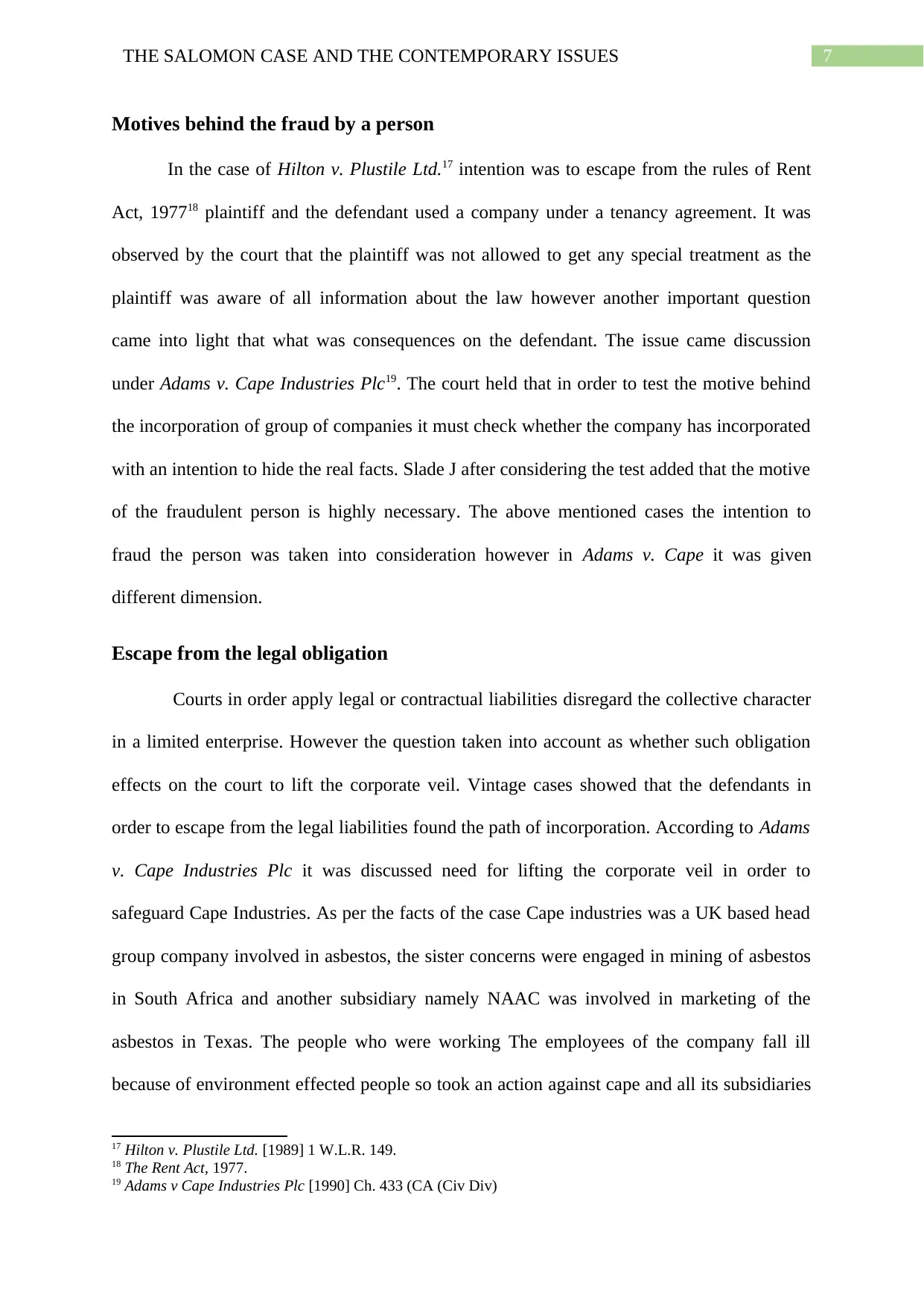
7THE SALOMON CASE AND THE CONTEMPORARY ISSUES
Motives behind the fraud by a person
In the case of Hilton v. Plustile Ltd.17 intention was to escape from the rules of Rent
Act, 197718 plaintiff and the defendant used a company under a tenancy agreement. It was
observed by the court that the plaintiff was not allowed to get any special treatment as the
plaintiff was aware of all information about the law however another important question
came into light that what was consequences on the defendant. The issue came discussion
under Adams v. Cape Industries Plc19. The court held that in order to test the motive behind
the incorporation of group of companies it must check whether the company has incorporated
with an intention to hide the real facts. Slade J after considering the test added that the motive
of the fraudulent person is highly necessary. The above mentioned cases the intention to
fraud the person was taken into consideration however in Adams v. Cape it was given
different dimension.
Escape from the legal obligation
Courts in order apply legal or contractual liabilities disregard the collective character
in a limited enterprise. However the question taken into account as whether such obligation
effects on the court to lift the corporate veil. Vintage cases showed that the defendants in
order to escape from the legal liabilities found the path of incorporation. According to Adams
v. Cape Industries Plc it was discussed need for lifting the corporate veil in order to
safeguard Cape Industries. As per the facts of the case Cape industries was a UK based head
group company involved in asbestos, the sister concerns were engaged in mining of asbestos
in South Africa and another subsidiary namely NAAC was involved in marketing of the
asbestos in Texas. The people who were working The employees of the company fall ill
because of environment effected people so took an action against cape and all its subsidiaries
17 Hilton v. Plustile Ltd. [1989] 1 W.L.R. 149.
18 The Rent Act, 1977.
19 Adams v Cape Industries Plc [1990] Ch. 433 (CA (Civ Div)
Motives behind the fraud by a person
In the case of Hilton v. Plustile Ltd.17 intention was to escape from the rules of Rent
Act, 197718 plaintiff and the defendant used a company under a tenancy agreement. It was
observed by the court that the plaintiff was not allowed to get any special treatment as the
plaintiff was aware of all information about the law however another important question
came into light that what was consequences on the defendant. The issue came discussion
under Adams v. Cape Industries Plc19. The court held that in order to test the motive behind
the incorporation of group of companies it must check whether the company has incorporated
with an intention to hide the real facts. Slade J after considering the test added that the motive
of the fraudulent person is highly necessary. The above mentioned cases the intention to
fraud the person was taken into consideration however in Adams v. Cape it was given
different dimension.
Escape from the legal obligation
Courts in order apply legal or contractual liabilities disregard the collective character
in a limited enterprise. However the question taken into account as whether such obligation
effects on the court to lift the corporate veil. Vintage cases showed that the defendants in
order to escape from the legal liabilities found the path of incorporation. According to Adams
v. Cape Industries Plc it was discussed need for lifting the corporate veil in order to
safeguard Cape Industries. As per the facts of the case Cape industries was a UK based head
group company involved in asbestos, the sister concerns were engaged in mining of asbestos
in South Africa and another subsidiary namely NAAC was involved in marketing of the
asbestos in Texas. The people who were working The employees of the company fall ill
because of environment effected people so took an action against cape and all its subsidiaries
17 Hilton v. Plustile Ltd. [1989] 1 W.L.R. 149.
18 The Rent Act, 1977.
19 Adams v Cape Industries Plc [1990] Ch. 433 (CA (Civ Div)
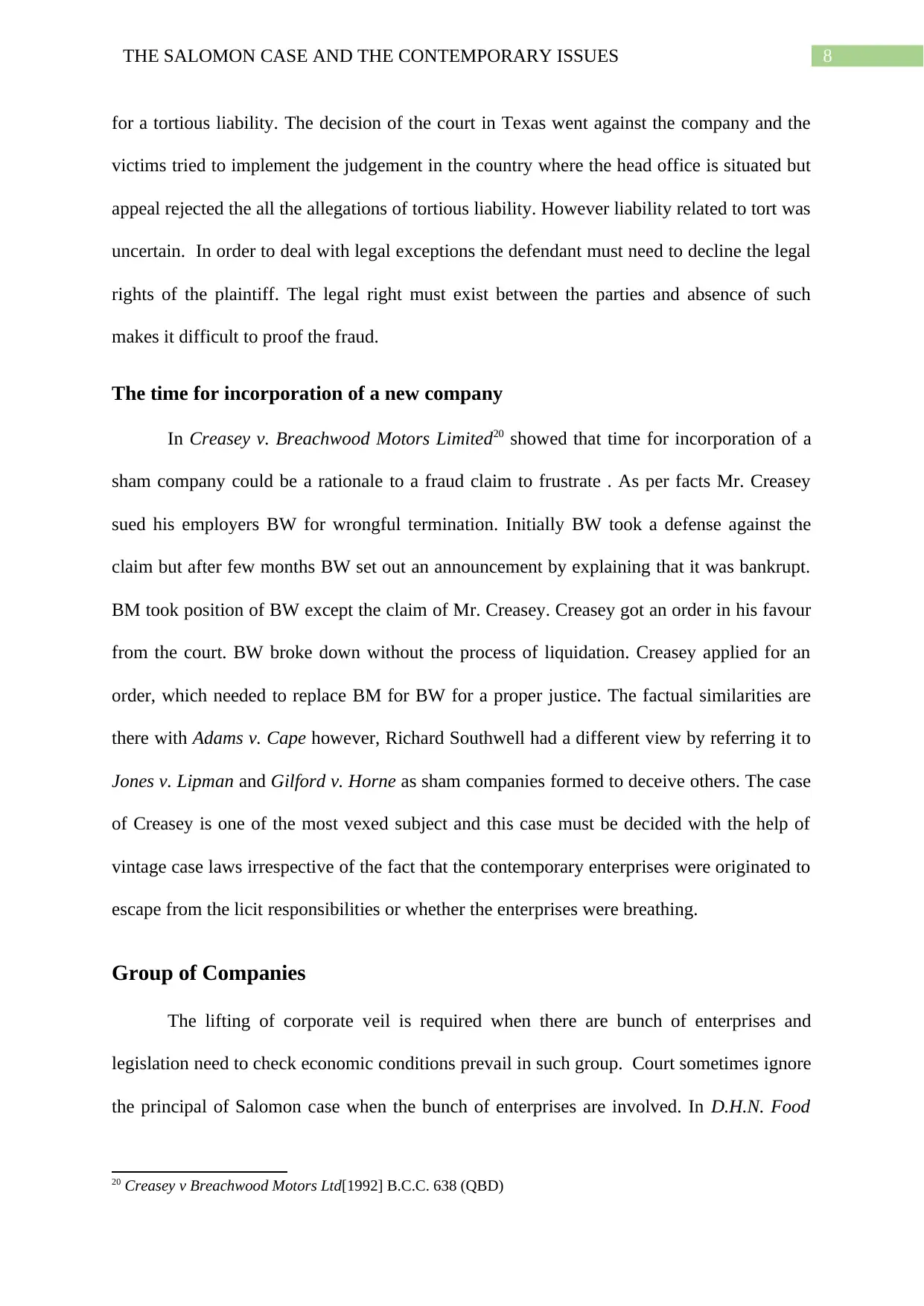
8THE SALOMON CASE AND THE CONTEMPORARY ISSUES
for a tortious liability. The decision of the court in Texas went against the company and the
victims tried to implement the judgement in the country where the head office is situated but
appeal rejected the all the allegations of tortious liability. However liability related to tort was
uncertain. In order to deal with legal exceptions the defendant must need to decline the legal
rights of the plaintiff. The legal right must exist between the parties and absence of such
makes it difficult to proof the fraud.
The time for incorporation of a new company
In Creasey v. Breachwood Motors Limited20 showed that time for incorporation of a
sham company could be a rationale to a fraud claim to frustrate . As per facts Mr. Creasey
sued his employers BW for wrongful termination. Initially BW took a defense against the
claim but after few months BW set out an announcement by explaining that it was bankrupt.
BM took position of BW except the claim of Mr. Creasey. Creasey got an order in his favour
from the court. BW broke down without the process of liquidation. Creasey applied for an
order, which needed to replace BM for BW for a proper justice. The factual similarities are
there with Adams v. Cape however, Richard Southwell had a different view by referring it to
Jones v. Lipman and Gilford v. Horne as sham companies formed to deceive others. The case
of Creasey is one of the most vexed subject and this case must be decided with the help of
vintage case laws irrespective of the fact that the contemporary enterprises were originated to
escape from the licit responsibilities or whether the enterprises were breathing.
Group of Companies
The lifting of corporate veil is required when there are bunch of enterprises and
legislation need to check economic conditions prevail in such group. Court sometimes ignore
the principal of Salomon case when the bunch of enterprises are involved. In D.H.N. Food
20 Creasey v Breachwood Motors Ltd[1992] B.C.C. 638 (QBD)
for a tortious liability. The decision of the court in Texas went against the company and the
victims tried to implement the judgement in the country where the head office is situated but
appeal rejected the all the allegations of tortious liability. However liability related to tort was
uncertain. In order to deal with legal exceptions the defendant must need to decline the legal
rights of the plaintiff. The legal right must exist between the parties and absence of such
makes it difficult to proof the fraud.
The time for incorporation of a new company
In Creasey v. Breachwood Motors Limited20 showed that time for incorporation of a
sham company could be a rationale to a fraud claim to frustrate . As per facts Mr. Creasey
sued his employers BW for wrongful termination. Initially BW took a defense against the
claim but after few months BW set out an announcement by explaining that it was bankrupt.
BM took position of BW except the claim of Mr. Creasey. Creasey got an order in his favour
from the court. BW broke down without the process of liquidation. Creasey applied for an
order, which needed to replace BM for BW for a proper justice. The factual similarities are
there with Adams v. Cape however, Richard Southwell had a different view by referring it to
Jones v. Lipman and Gilford v. Horne as sham companies formed to deceive others. The case
of Creasey is one of the most vexed subject and this case must be decided with the help of
vintage case laws irrespective of the fact that the contemporary enterprises were originated to
escape from the licit responsibilities or whether the enterprises were breathing.
Group of Companies
The lifting of corporate veil is required when there are bunch of enterprises and
legislation need to check economic conditions prevail in such group. Court sometimes ignore
the principal of Salomon case when the bunch of enterprises are involved. In D.H.N. Food
20 Creasey v Breachwood Motors Ltd[1992] B.C.C. 638 (QBD)
⊘ This is a preview!⊘
Do you want full access?
Subscribe today to unlock all pages.

Trusted by 1+ million students worldwide
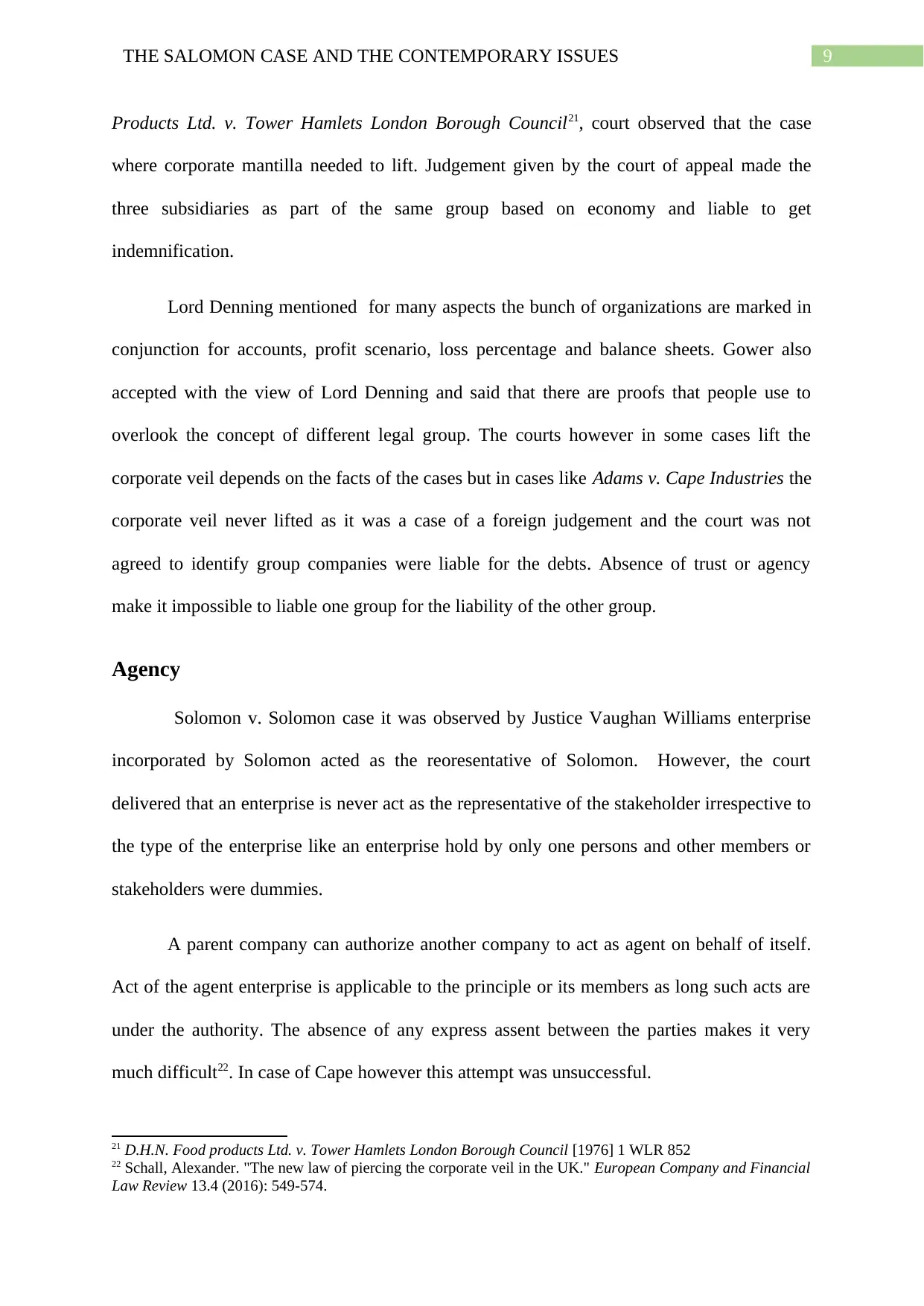
9THE SALOMON CASE AND THE CONTEMPORARY ISSUES
Products Ltd. v. Tower Hamlets London Borough Council21, court observed that the case
where corporate mantilla needed to lift. Judgement given by the court of appeal made the
three subsidiaries as part of the same group based on economy and liable to get
indemnification.
Lord Denning mentioned for many aspects the bunch of organizations are marked in
conjunction for accounts, profit scenario, loss percentage and balance sheets. Gower also
accepted with the view of Lord Denning and said that there are proofs that people use to
overlook the concept of different legal group. The courts however in some cases lift the
corporate veil depends on the facts of the cases but in cases like Adams v. Cape Industries the
corporate veil never lifted as it was a case of a foreign judgement and the court was not
agreed to identify group companies were liable for the debts. Absence of trust or agency
make it impossible to liable one group for the liability of the other group.
Agency
Solomon v. Solomon case it was observed by Justice Vaughan Williams enterprise
incorporated by Solomon acted as the reoresentative of Solomon. However, the court
delivered that an enterprise is never act as the representative of the stakeholder irrespective to
the type of the enterprise like an enterprise hold by only one persons and other members or
stakeholders were dummies.
A parent company can authorize another company to act as agent on behalf of itself.
Act of the agent enterprise is applicable to the principle or its members as long such acts are
under the authority. The absence of any express assent between the parties makes it very
much difficult22. In case of Cape however this attempt was unsuccessful.
21 D.H.N. Food products Ltd. v. Tower Hamlets London Borough Council [1976] 1 WLR 852
22 Schall, Alexander. "The new law of piercing the corporate veil in the UK." European Company and Financial
Law Review 13.4 (2016): 549-574.
Products Ltd. v. Tower Hamlets London Borough Council21, court observed that the case
where corporate mantilla needed to lift. Judgement given by the court of appeal made the
three subsidiaries as part of the same group based on economy and liable to get
indemnification.
Lord Denning mentioned for many aspects the bunch of organizations are marked in
conjunction for accounts, profit scenario, loss percentage and balance sheets. Gower also
accepted with the view of Lord Denning and said that there are proofs that people use to
overlook the concept of different legal group. The courts however in some cases lift the
corporate veil depends on the facts of the cases but in cases like Adams v. Cape Industries the
corporate veil never lifted as it was a case of a foreign judgement and the court was not
agreed to identify group companies were liable for the debts. Absence of trust or agency
make it impossible to liable one group for the liability of the other group.
Agency
Solomon v. Solomon case it was observed by Justice Vaughan Williams enterprise
incorporated by Solomon acted as the reoresentative of Solomon. However, the court
delivered that an enterprise is never act as the representative of the stakeholder irrespective to
the type of the enterprise like an enterprise hold by only one persons and other members or
stakeholders were dummies.
A parent company can authorize another company to act as agent on behalf of itself.
Act of the agent enterprise is applicable to the principle or its members as long such acts are
under the authority. The absence of any express assent between the parties makes it very
much difficult22. In case of Cape however this attempt was unsuccessful.
21 D.H.N. Food products Ltd. v. Tower Hamlets London Borough Council [1976] 1 WLR 852
22 Schall, Alexander. "The new law of piercing the corporate veil in the UK." European Company and Financial
Law Review 13.4 (2016): 549-574.
Paraphrase This Document
Need a fresh take? Get an instant paraphrase of this document with our AI Paraphraser

10THE SALOMON CASE AND THE CONTEMPORARY ISSUES
Trust
For the trust of an organization example of a case can be analyzed. Abbey and
Planning the school was running similar to an enterprise but the shares were availed by the
trustees. Trustees were from different educational sectors and here the court stepped into the
case in order to check the actual scenario of shares.
There are other factors like Tax legislations and war conditions which involves a case
law namely Daimler Co Ltd v. Continental Tyre & Rubber Co (Great Britain) Ltd23 when
court decided to lift the mantilla.
Tort
Cases related to tort mostly neglected by the court in order to decide by the Salomon
case.
Conclusion
From the above discussion it can be concluded that the principle of separate legal
entity are observed in many cases however there are cases which are observing the lifting of
corporate veil. The landmark judgement of Solomon v Solomon followed by many classic
cases where the court observed the principle of separate legal entity. In modern times the
judicial discretion has observed in to order to lift the corporate veil. In present circumstances
if the court follows the strict principle of separate legal entity then there will be chances to
unjust if there is any unfair factor involved in the case. The courts have explained that a party
cannot use the shield of the separate corporate form in order to hide fraud and escape from
legal liabilities. From the above case laws we have already seen that what are situations when
the Solomon principle will be restricted. However there are no such determined guidelines
which will help the legislation to understand in what circumstances the principle of Solomon
23 Daimler Co Ltd v. Continental Tyre & Rubber Co (Great Britain) Ltd [1916] 2 A.C. 307 (HL)
Trust
For the trust of an organization example of a case can be analyzed. Abbey and
Planning the school was running similar to an enterprise but the shares were availed by the
trustees. Trustees were from different educational sectors and here the court stepped into the
case in order to check the actual scenario of shares.
There are other factors like Tax legislations and war conditions which involves a case
law namely Daimler Co Ltd v. Continental Tyre & Rubber Co (Great Britain) Ltd23 when
court decided to lift the mantilla.
Tort
Cases related to tort mostly neglected by the court in order to decide by the Salomon
case.
Conclusion
From the above discussion it can be concluded that the principle of separate legal
entity are observed in many cases however there are cases which are observing the lifting of
corporate veil. The landmark judgement of Solomon v Solomon followed by many classic
cases where the court observed the principle of separate legal entity. In modern times the
judicial discretion has observed in to order to lift the corporate veil. In present circumstances
if the court follows the strict principle of separate legal entity then there will be chances to
unjust if there is any unfair factor involved in the case. The courts have explained that a party
cannot use the shield of the separate corporate form in order to hide fraud and escape from
legal liabilities. From the above case laws we have already seen that what are situations when
the Solomon principle will be restricted. However there are no such determined guidelines
which will help the legislation to understand in what circumstances the principle of Solomon
23 Daimler Co Ltd v. Continental Tyre & Rubber Co (Great Britain) Ltd [1916] 2 A.C. 307 (HL)
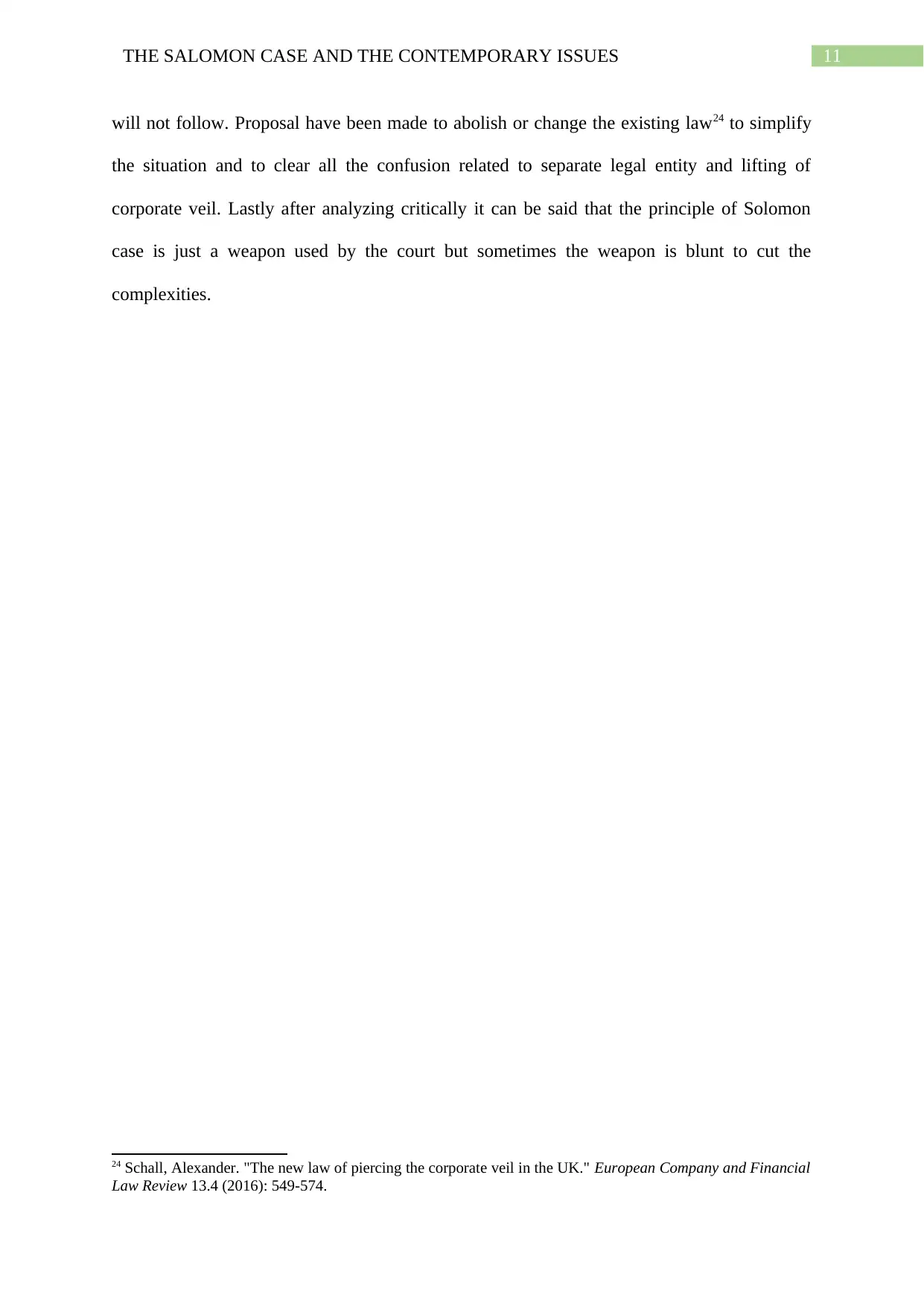
11THE SALOMON CASE AND THE CONTEMPORARY ISSUES
will not follow. Proposal have been made to abolish or change the existing law24 to simplify
the situation and to clear all the confusion related to separate legal entity and lifting of
corporate veil. Lastly after analyzing critically it can be said that the principle of Solomon
case is just a weapon used by the court but sometimes the weapon is blunt to cut the
complexities.
24 Schall, Alexander. "The new law of piercing the corporate veil in the UK." European Company and Financial
Law Review 13.4 (2016): 549-574.
will not follow. Proposal have been made to abolish or change the existing law24 to simplify
the situation and to clear all the confusion related to separate legal entity and lifting of
corporate veil. Lastly after analyzing critically it can be said that the principle of Solomon
case is just a weapon used by the court but sometimes the weapon is blunt to cut the
complexities.
24 Schall, Alexander. "The new law of piercing the corporate veil in the UK." European Company and Financial
Law Review 13.4 (2016): 549-574.
⊘ This is a preview!⊘
Do you want full access?
Subscribe today to unlock all pages.

Trusted by 1+ million students worldwide
1 out of 15
Related Documents
Your All-in-One AI-Powered Toolkit for Academic Success.
+13062052269
info@desklib.com
Available 24*7 on WhatsApp / Email
![[object Object]](/_next/static/media/star-bottom.7253800d.svg)
Unlock your academic potential
Copyright © 2020–2025 A2Z Services. All Rights Reserved. Developed and managed by ZUCOL.





